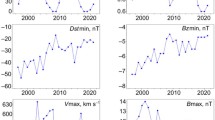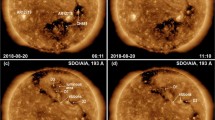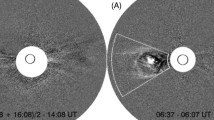Abstract
More than 140 isolated non-recurrent geomagnetic storms (GMSs) of various intensities from extreme to weak are considered; these are reliably identified with solar eruptive sources (coronal mass ejections, CMEs). The analysis aims to obtain a possibly complete picture of the relationship between the transit time of propagation of CMEs and interplanetary coronal mass ejections (ICMEs) from the Sun to the Earth (more precisely, the time interval \(\Delta t_{p}\) from the moment of an eruption until the peak of the corresponding GMS) and the maximum intensity of this GMS, as measured by the disturbance storm time geomagnetic index Dst. Two groups of events are singled out: one includes GMSs, the source of which was an eruption from an active region (AR events), the other GMSs caused by filament eruptions from quiescent areas of the Sun located outside ARs (QS events). The distribution of the large number of the analyzed events on a \(\Delta t_{p}\) – Dst plane confirms and substantially clarifies the known regularities. The AR events are characterized by a shorter transit time (\(\Delta t_{p} \approx 1\)–4 days) and much stronger GMSs (Dst up to –600 nT mainly) in comparison with the QS events (\(\Delta t_{p} \approx 3\)–5 days, Dst > –200 nT). For events of both groups, the shorter the transit time of CMEs/ICMEs, the more intense the GMSs; in particular, for AR events when \(\Delta t_{p}\) declines from 4 to 1 day, Dst decreases on average from –100 to –470 nT and can reach – 900 nT. From the point of view of the nature of GMSs and their sources on the Sun, the obtained results mean that both the speed of CMEs/ICMEs and the strength of the magnetic field transported by them are largely determined by the parameters of the corresponding eruptions, in particular, by the eruptive magnetic flux and the released energy.

Similar content being viewed by others
References
Abunin, A.A., Abunina, M.A., Belov, A.V., Chertok, I.M.: 2020, Peculiar solar sources and geospace disturbances on 20–26 August 2018. Solar Phys.295(1), 7. DOI.
Ameri, D., Valtonen, E.: 2017, Investigation of the geoeffectiveness of disk-centre full-halo coronal mass ejections. Solar Phys.292(6), 79. DOI.
Baker, D.N., Li, X., Pulkkinen, A., Ngwira, C.M., Mays, M.L., Galvin, A.B., Simunac, K.D.C.: 2013, A major solar eruptive event in July 2012: defining extreme space weather scenarios. Space Weather11(10), 585. DOI.
Boteler, D.H.: 2019, A twenty-first century view of the March 1989 magnetic storm. Space Weather17(10), 1427. DOI.
Chen, C., Liu, Y.D., Wang, R., Zhao, X., Hu, H., Zhu, B.: 2019, Characteristics of a gradual filament eruption and subsequent CME propagation in relation to a strong geomagnetic storm. Astrophys. J.884(1), 90. DOI.
Chertok, I.M., Grechnev, V.V., Belov, A.V., Abunin, A.A.: 2013, Magnetic flux of EUV arcade and dimming regions as a relevant parameter for early diagnostics of solar eruptions – sources of non-recurrent geomagnetic storms and Forbush decreases. Solar Phys.282(1), 175. DOI.
Cliver, E.W., Crooker, N.U.: 1993, A seasonal dependence for the geoeffectiveness of eruptive solar events. Solar Phys.145(2), 347. DOI.
Cliver, E.W., Dietrich, W.F.: 2013, The 1859 space weather event revisited: limits of extreme activity. J. Space Weather Space Clim.3, A31. DOI.
Cliver, E.W., Svalgaard, L.: 2004, The 1859 solar-terrestrial disturbance and the current limits of extreme space weather activity. Solar Phys.224(1–2), 407. DOI.
Cliver, E.W., Balasubramaniam, K.S., Nitta, N.V., Li, X.: 2009, Great geomagnetic storm of 9 November 1991: association with a disappearing solar filament. J. Geophys. Res.114(3), A00A20. DOI.
Dave, K., Mishra, W., Srivastava, N., Jadhav, R.M.: 2018, Study of interplanetary and geomagnetic response of filament associated CMEs. Proc. Int. Astron. Union340, 83. DOI.
Davis, C.J., de Koning, C.A., Davies, J.A., Biesecker, D., Millward, G., Dryer, M., et al.: 2011, A comparison of space weather analysis techniques used to predict the arrival of the Earth-directed CME and its shockwave launched on 8 April 2010. Space Weather9(1), S01005. DOI.
Dissauer, K., Veronig, A.M., Temmer, M., Podladchikova, T., Vanninathan, K.: 2018, Statistics of coronal dimmings associated with coronal mass ejections. I. Characteristic dimming properties and flare association. Astrophys. J.863(2), 169. DOI.
Dumbović, M., Devos, A., Vršnak, B., Sudar, D., Rodriguez, L., Ruždjak, D., et al.: 2015, Geoeffectiveness of coronal mass ejections in the SOHO era. Solar Phys.290(2), 579. DOI.
Gonzalez, W.D., Echer, E., de Gonzalez, A.L.C., Tsurutani, B.T., Lakhina, G.S.: 2011, Extreme geomagnetic storms, recent Gleissberg cycles and space era-superintense storms. J. Atmos. Solar-Terr. Phys.73(11–12), 1447. DOI.
Gopalswamy, N.: 2010, The CME link to geomagnetic storms. Proc. Int. Astron. Union264, 326. DOI.
Gopalswamy, N.: 2016, History and development of coronal mass ejections as a key player in solar terrestrial relationship. Geosci. Lett.3, 8. DOI.
Gopalswamy, N.: 2018, Extreme solar eruptions and their space weather consequences. In: Buzulukova, N. (ed.) Extreme Events in Geospace. Origins, Predictability, and Consequences, Elsevier, Amsterdam 37. DOI.
Gopalswamy, N., Tsurutani, B., Yan, Y.: 2015, Short-term variability of the Sun-Earth system: an overview of progress made during the CAWSES-II period. Prog. Earth Planet. Sci.2, 13. DOI.
Gopalswamy, N., Yashiro, S., Michalek, G., Stenborg, G., Vourlidas, A., Freeland, S., Howard, R.: 2009, The SOHO/LASCO CME catalog. Earth Moon Planets104(1–4), 295. DOI.
Gopalswamy, N., Yashiro, S., Akiyama, S., Xie, H.: 2017, Estimation of reconnection flux using post-eruption arcades and its relevance to magnetic clouds at 1 AU. Solar Phys.292(4), 65. DOI.
Gosling, J.T.: 1993, The solar flare myth. J. Geophys. Res.98(A11), 18,937. DOI.
Grechnev, V.V., Uralov, A.M., Chertok, I.M., Belov, A.V., Filippov, B.P., Slemzin, V.A., Jackson, B.V.: 2014, A challenging solar eruptive event of 18 November 2003 and the causes of the 20 November geomagnetic superstorm. IV. Unusual magnetic cloud and overall scenario. Solar Phys.289(12), 4653. DOI.
Hapgood, M.: 2019, The great storm of May 1921: an exemplar of a dangerous space weather event. Space Weather17(7), 950. DOI.
Hayakawa, H., Ebihara, Y., Cliver, E.W., Hattori, K., Toriumi, S., Love, J.J., et al.: 2019, The extreme space weather event in September 1909. Mon. Not. Roy. Astron. Soc.484(3), 4083. DOI.
Hayakawa, H., Ribeiro, P., Vaquero, J.M., Gallego, M.C., Knipp, D.J., Mekhaldi, F., et al.: 2020, The extreme space weather event in 1903 October/November: an outburst from the quiet Sun. Astrophys. J. Lett., submitted. arXiv. DOI.
He, W., Liu, Y.D., Hu, H., Wang, R., Zhao, X.: 2018, A stealth CME bracketed between slow and fast wind producing unexpected geo-effectiveness. Astrophys. J.860(1), 78. DOI.
Ibrahim, M.S., Joshi, B., Cho, K.-S., Kim, R.-S., Moon, Y.-J.: 2019, Interplanetary coronal mass ejections during solar cycles 23 and 24: Sun–Earth propagation characteristics and consequences at the near-Earth region. Solar Phys.294(6), 54. DOI.
Joselyn, J.A., McIntosh, P.S.: 1981, Disappearing solar filaments: a useful predictor of geomagnetic activity. J. Geophys. Res.86(A6), 4555. DOI.
Kazachenko, M.D., Lynch, B.J., Welsch, B., Sun, X.: 2017, A database of flare ribbon properties from the Solar Dynamics Observatory. I. Reconnection flux. Astrophys. J.845(1), 49. DOI.
Kilpua, E., Koskinen, H.E.J., Pulkkinen, T.: 2017, Coronal mass ejections and their sheath regions in interplanetary space. Living Rev. Solar Phys.14, 5. DOI.
Kim, R.-S., Cho, K.-S., Moon, Y.-J., Dryer, M., Lee, J., Yi, Y., et al.: 2010, An empirical model for prediction of geomagnetic storms using initially observed CME parameters at the Sun. J. Geophys. Res.115(A12), 12108. DOI.
Lefèvre, L., Vennerstrøm, S., Dumbović, M., Vršnak, B., Sudar, D., Arlt, R., et al.: 2016, Detailed analysis of solar data related to historical extreme geomagnetic storms: 1868–2010. Solar Phys.291(5), 1483. DOI.
Li, Y., Luhmann, J.G., Lynch, B.J.: 2018, Magnetic clouds: solar cycle dependence, sources, and geomagnetic impacts. Solar Phys.293(10), 135. DOI.
Liu, Y.D., Luhmann, J.G., Kajdič, P., Kilpua, E.K.J., Lugaz, N., Nitta, N.V., et al.: 2014, Observations of an extreme storm in interplanetary space caused by successive coronal mass ejections. Nat. Commun.5, 3481. DOI.
Love, J.J., Hayakawa, H., Cliver, E.W.: 2019, On the intensity of the magnetic superstorm of September 1909. Space Weather17(1), 37. DOI.
Manchester, W. IV, Kilpua, E.K.J. , Liu, Y.D., Lugaz, N., Riley, P., Török, T., Vršnak, B.: 2017, The physical processes of CME/ICME evolution. Space Sci. Rev.212(3–4), 1159. DOI.
McAllister, A.H., Dryer, M., Mcintosh, P., Singer, H., Weiss, L.: 1996, A large polar crown CME and a “problem” geomagnetic storm: April 14–23, 1994. J. Geophys. Res.101(A6), 13,497. DOI.
Michalek, G., Gopalswamy, N., Yashiro, S.: 2008, Space weather application using projected velocity asymmetry of halo CMEs. Solar Phys.248(1), 113. DOI.
Newton, H.W.: 1943, Solar flares and magnetic storms. Mon. Not. Roy. Astron. Soc.103(5), 244. DOI.
Newton, H.W.: 1944, Solar flares and magnetic storms (second paper). Mon. Not. Roy. Astron. Soc.104(1), 4. DOI.
Pal, S., Nandy, D., Srivastava, N., Gopalswamy, N., Panda, S.: 2018, Dependence of coronal mass ejection properties on their solar source active region characteristics and associated flare reconnection flux. Astrophys. J.865(1), 4. DOI.
Richardson, I.G., Cane, H.V.: 2010, Near-Earth interplanetary coronal mass ejections during solar cycle 23 (1996–2009): catalog and summary of properties. Solar Phys.264(1), 189. DOI. See data after 2009 at http://www.srl.caltech.edu/ACE/ASC/DATA/level3/icmetable2.htm.
Shanmugaraju, A., Ibrahim, M.S., Moon, Y.-J., Rahman, A.M., Umapathy, S.: 2015, Empirical relationship between CME parameters and geo-effectiveness of halo CMEs in the rising phase of solar cycle 24 (2011–2013). Solar Phys.290(5), 1417. DOI.
Srivastava, N., Venkatakrishnan, P.: 2004, Solar and interplanetary sources of major geomagnetic storms during 1996–2002. J. Geophys. Res.109(A10), 10,103. DOI.
Sugiura, M., Kamei, T.: 1991, Equatorial Dst index 1957–1986. IAGA Bull.40, 1. http://wdc.kugi.kyoto-u.ac.jp/Dstdir/Dst2/onDstindex.html.
Tsurutani, B., Gonzalez, W.D., Tang, F., Lee, Y.T.: 1992, Great magnetic storms. Geophys. Res. Lett.19(1), 73. DOI.
Vaisberg, O.L., Zastenker, G.N.: 1976, Solar wind and magnetosheath observations at Earth during August 1972. Space Sci. Rev.19(4–5), 687. DOI.
Wang, R., Liu, Y.D., Hu, H., Zhao, X.: 2018, A solar eruption with relatively strong geo-effectiveness originating from active region peripheral diffusive polarities. Astrophys. J.863(1), 81. DOI.
Webb, D., Howard, T.A.: 2012, Coronal mass ejections: observations. Living Rev. Solar Phys.9, 3. DOI.
Webb, D., Nitta, N.: 2017, Understanding problem forecasts of ISEST campaign flare-CME events. Solar Phys.292(10), 142. DOI.
Wu, C-C., Liou, R.K., Lepping, P., Hutting, L.: 2019, The 04–10 September 2017 Sun–Earth connection events: solar flares, coronal mass ejections/magnetic clouds, and geomagnetic storms. Solar Phys.294(8), 110. DOI.
Yashiro, S., Gopalswamy, N., Michalek, G., St. Cyr, O.C., Plunkett, S.P., Rich, N.B., Howard, R.A.: 2004, A catalog of white light coronal mass ejections observed by the SOHO spacecraft. J. Geophys. Res.109(A7), A07105. DOI. https://cdaw.gsfc.nasa.gov/CME_list/.
Yermolaev, Yu.I., Lodkina, I.G., Nikolaeva, N.S., Yermolaev, M.Yu.: 2018, Geoeffectiveness of solar and interplanetary structures and generation of strong geomagnetic storms. In: Buzulukova, N. (ed.) Extreme Events in Geospace. Origins, Predictability, and Consequences, Elsevier, Amsterdam 99. DOI.
Zhang, J., Richardson, I.G., Webb, D.F., Gopalswamy, N., Huttunen, E., Kasper, J., et al.: 2007a, Solar and interplanetary sources of major geomagnetic storms (Dst ≤100 nT) during 1996–2005. J. Geophys. Res.112(A10), 10102. DOI.
Zhang, J., Richardson, I.G., Webb, D.F., Gopalswamy, N., Huttunen, E., Kasper, J., et al.: 2007b, Correction to “Solar and interplanetary sources of major geomagnetic storms (\(\mathrm{Dst} \leq 100\) nT) during 1996–2005”. J. Geophys. Res.112(A12), 12103. DOI.
Zou, P., Jiang, C., Wei, F., Zuo, P., Wang, Y.: 2019, A statistical study of solar filament eruptions that forms high-speed coronal mass ejections. Astrophys. J.884(2), 157. DOI.
Acknowledgements
The author thanks an anonymous reviewer for useful remarks and comments. The author is grateful to the teams and numerous colleagues whose data and results are used in this analysis. This research was partially supported by the Russian Foundation of Basic Research under grants 17-02-00308 and by the Complex Program 19–270 of the Russian Ministry of Education and Science.
Author information
Authors and Affiliations
Corresponding author
Ethics declarations
Disclosure of Potential Conflicts of Interest
The author declares that there are no conflicts of interests.
Additional information
Publisher’s Note
Springer Nature remains neutral with regard to jurisdictional claims in published maps and institutional affiliations.
This article belongs to the Topical Collection:
Towards Future Research on Space Weather Drivers
Guest Editors: Hebe Cremades and Teresa Nieves-Chinchilla
Rights and permissions
About this article
Cite this article
Chertok, I.M. On the Relationship Between the Transit Time of ICMEs and Strength of the Initiated Geomagnetic Storms. Sol Phys 295, 74 (2020). https://doi.org/10.1007/s11207-020-01640-0
Received:
Accepted:
Published:
DOI: https://doi.org/10.1007/s11207-020-01640-0




